In this article, you will learn the different parts of boat and their functions. All are explained with Names & Pictures.
You can also download the PDF file of this article at the end.
Boat Parts
The boat is a small vessel that is used for traveling over water, mainly propelled by an engine or by oars to move the vessel. The term boat refers to a variety of different types and sizes of watercraft but is generally smaller than a ship, which may be distinguished by its larger size, shape, cargo, or passenger capacity.
Small boats are usually found on inland waterways such as rivers and lakes or in protected coastal areas. Whereas other types, such as whaleboats, were used in offshore environments. Boats are vessels that can be carried on ships in modern naval terms.
Boat manufacturing methods vary with their intended purpose, available materials, or local traditions. Furthermore, there are many parts of it that most people are not aware of. Before we get to ride on the water in a boat, we need to learn a few specific words that are all used to describe common parts of boats.
Let’s understand them one by one below.
Read Also: Different Types of Ships and Their Functions [Names & Images]
Parts of Boat
The following are the important parts of boat:
- Ballast
- Hull
- Deck
- Bow
- Stern
- Port and starboard
- Gunwale
- Cleat
- Bilge
- Bimini
- Propeller
- Bulkhead
- Cabin
- Cockpit
- Gallery
- Casting deck
- Dinette
- Hardtop
- Flybridge
- Hatch
- Helm
- Livewell
- Rigging
- Saloon
- T-top
- Transom
- V-berth
- Rudder
- Swim-platform
- Console
- All-round light
- Fender
#1 Ballast
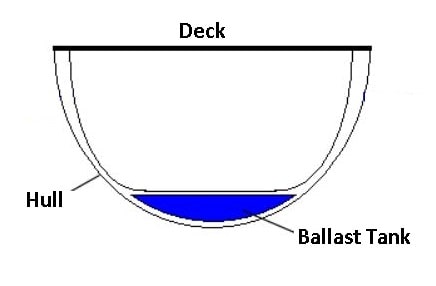
In a boat, ship, submarine, or other floating structure, ballast refers to a compartment that contains water. The water from the ballast tank must move in and out to balance the ship. The reason for installing this part is to improve the stability and performance of the boat.
The ballast is typically placed in the bottom of the hull, resulting in a very high center of gravity. You need a lot of ballast to keep the boat tight. A boat that does not have ballast will have difficulty navigating the treacherous waters.
#2 Hull
A hull is commonly referred to as a watertight body or shell of a boat. It may open at the top, such as a sailboat, or it may be completely or partially covered by a deck.
Gunwales are provided on the upper sides of the hull of the boat. In nautical terms, the waterline is the point where the hull meets the surface of the water. Modern types of cruise ships are built with hulls consisting of heavy steel panels welded together.
#3 Deck
In a ship, a deck is a compartment or a permanent cover over the hull. The upper deck of a boat or ship is the horizontal structure that serves as the primary working surface, strengthens the hull, and forms its roof. This part is usually located on top of the hull where you can walk or work.
#4 Bow
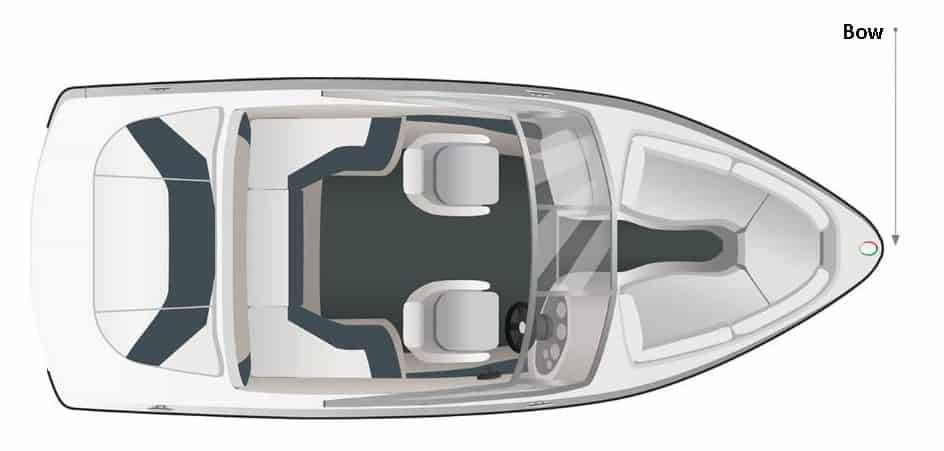
The area at the front of the boat is commonly referred to as the bow. When looking at the bow, the left side of the boat is towards the port. It is important to know where the bow is in order to define two other common sailing terms: port and starboard.
The name ‘bow’ was given to the front part of the ship because, in Medieval ships, the strakes (planks) had to be bent or ‘bowed’ to make the curved or ‘bowed’ part of the ship cut through the water better.
#5 Stern

The area at the back of the boat is commonly referred to as the stern. When people originally mentioned the stern of a boat, they meant the port aft section. However, nowadays, if you hear the word stern, it means the entire rear of the boat. In addition, this part is highlighted by a white navigation light at night.
Read Also: Working of Leaf Spring Suspension System
#6 Port and Starboard
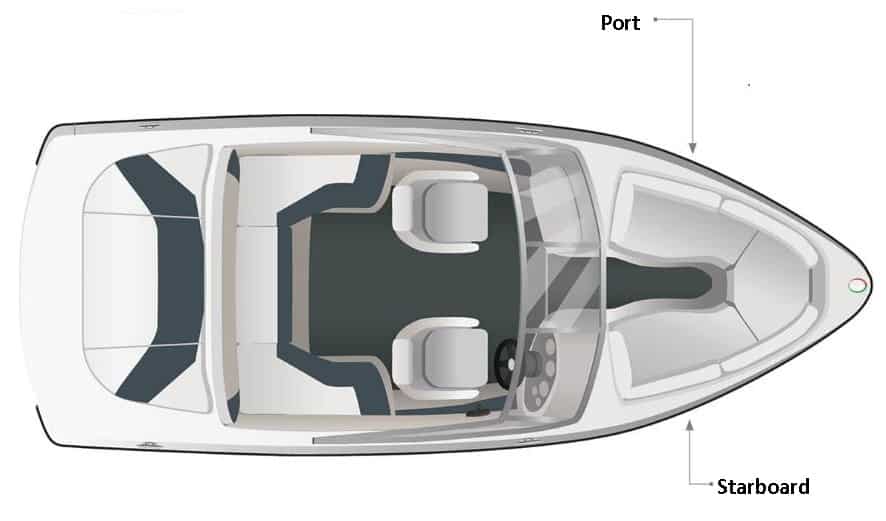
In reference to the bow of the boat, port refers to the left side, while starboard refers to the right side. It is the case for vessels with bilateral symmetry that the left and right sides are mirror images of each other. There is one asymmetrical feature in that access to boats, ships, and airplanes are mostly on the port side (hence the name).
#7 Gunwale
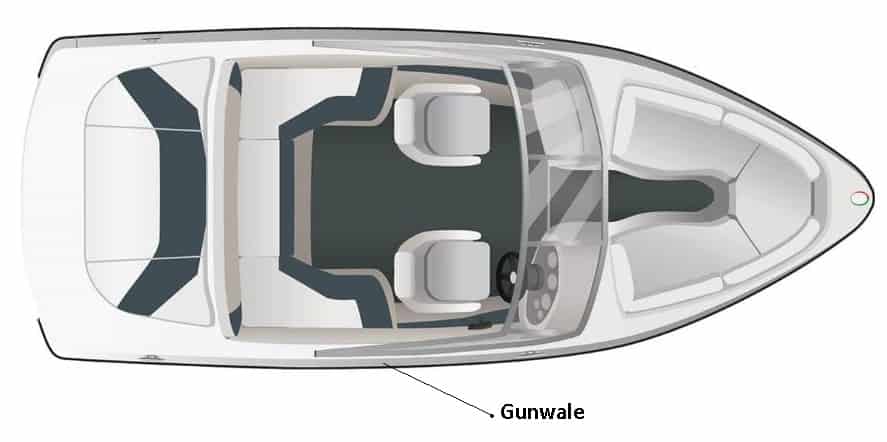
The upper edge of the side of a ship or boat is called a gunwale. Also known as a gunnel, this is usually where the deck and rudder come together. On a canoe, the gunwale usually has a wide edge at the top, supported with wood, plastic, or aluminum, to carry the sway.
The reason it is called a gunwale is that from the earliest days of the navy, the top edge of the ship was a very handy place to store a gun to defend against enemies and pirates.
#8 Cleat
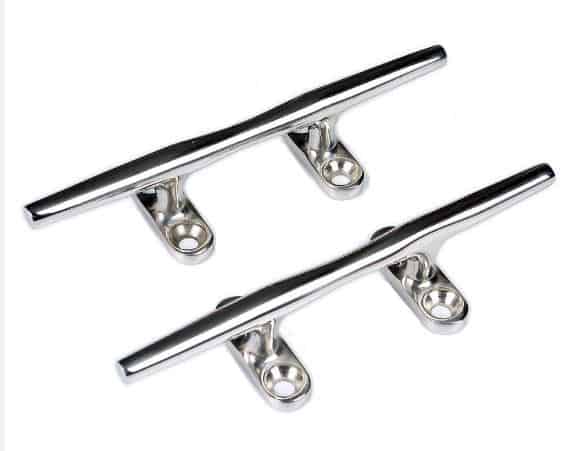
A cleat is a device for securing a rope in a boat or ship. The cleat is usually made of wood, plastic, or metal fittings which are used for tying or looping a line. It can be found on a boat or dock.
These are iconic pieces of marine technology not limited to sailboats. However, cleats are more important on sailboats than on any other type of ship.
#9 Bilge
A bilge is a compartment at the lowest point of a boat’s hull that collects water. If the boat is not supported by water, this part will rest on the ground. The boat will sink if too much water enters the bilge too quickly. To avoid this, the bilge also has a pump that helps remove the water collected in the bilge, which is located under the inside of the hull.
#10 Bimini
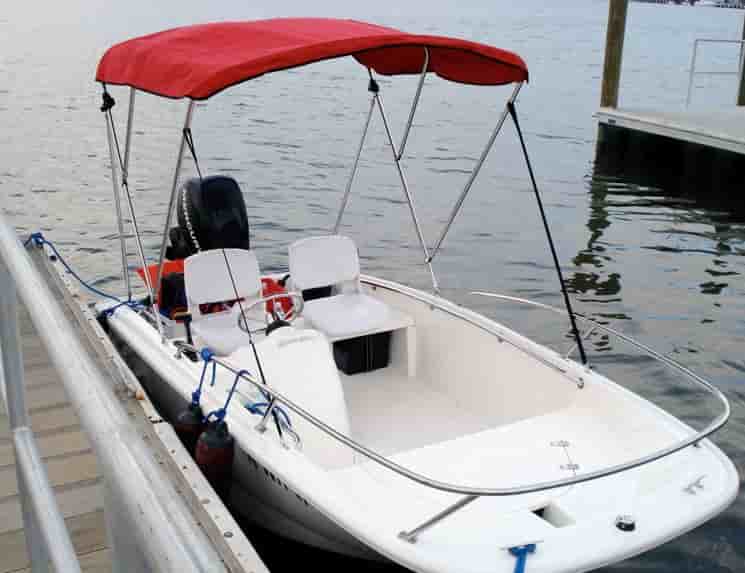
It is a canvas or composite top attached to the boat to provide protection from the sunlight. As a protection from the sun, it does not provide any protection from wind, rain, or spray when moving at any speed.
This top only provides protection when the boat is stationary, and there is no wind. In addition to its function, it can also be personalized and come in a variety of colors to fit a variety of boats.
Read Also: Important Parts of Bike Engine and Their Functions
#11 Propeller
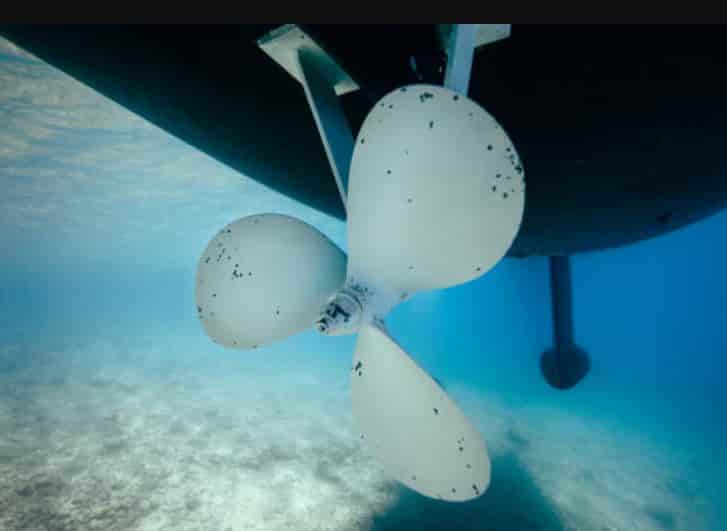
A propeller is a rotating device having blades to move a boat forward or backward through the water. It consists of a rotating hub and radiating blades, which are set to a pitch to form a spiral and, when rotated, exert linear thrust on a working fluid.
A propeller, known as a ‘screw’ for its form, is a fan-like machinery attached to the stern of a ship. They are available in many varieties and designs and can be left-hand turns or right-hand turns.
#12 Bulkhead
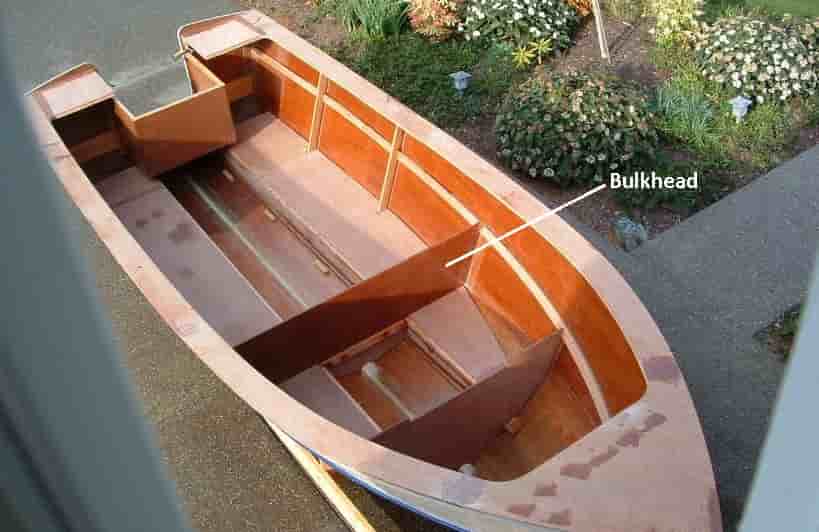
A bulkhead is a straight wall within a boat’s hull. Its main purpose is to prevent corrosion caused by the water that surrounds your property and acts as a barrier between it and the water. Their main purpose is to increase the structural rigidity of the vessel.
In addition, it creates a watertight compartment that can hold water in the event of a hull break or other leak. Some bulkheads are also built with fire resistance to receiving compartmentalization, a passive fire safety measure.
#13 Cabin
A cabin is a room inside a boat, referring to the whole interior of the boat. Simply put, cabins are bedrooms on boats, although they are designed for sleeping. Luxury yachts typically serve 10-12 guests with at least 4-5 cabins.
#14 Cockpit
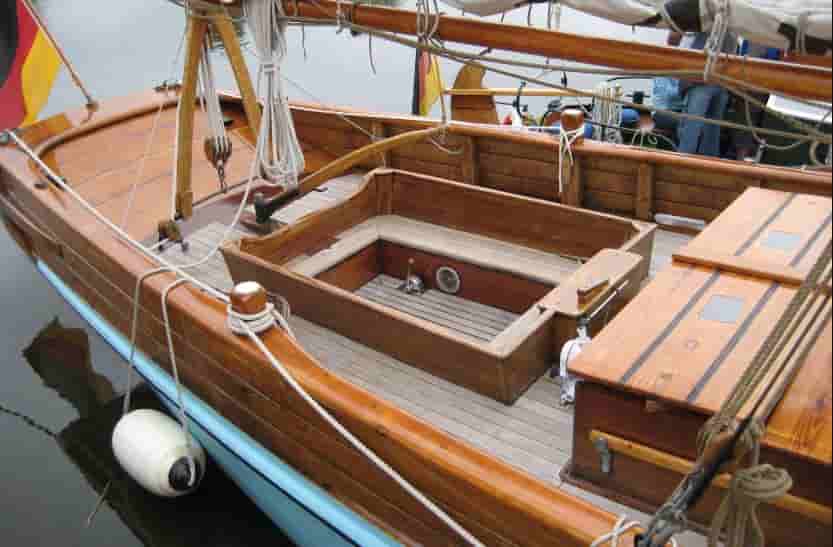
A cockpit is an area where the boat’s controls are located. Modern boats may have an enclosed cockpit rather than an open well on deck in deck outside a deckhouse or cabin. Smaller boats usually have a cockpit towards the rear of the boat, while larger vessels may offer a center cockpit with protection from rain, sun, and wind.
#15 Gallery
Generally, the gallery in a boat refers to the kitchen. The kitchen may be located inside the boat or outside on the deck, depending on the design of the boat.
Read Also: 20 Car Interior Parts and Their Functions [with Pictures]
#16 Casting Deck
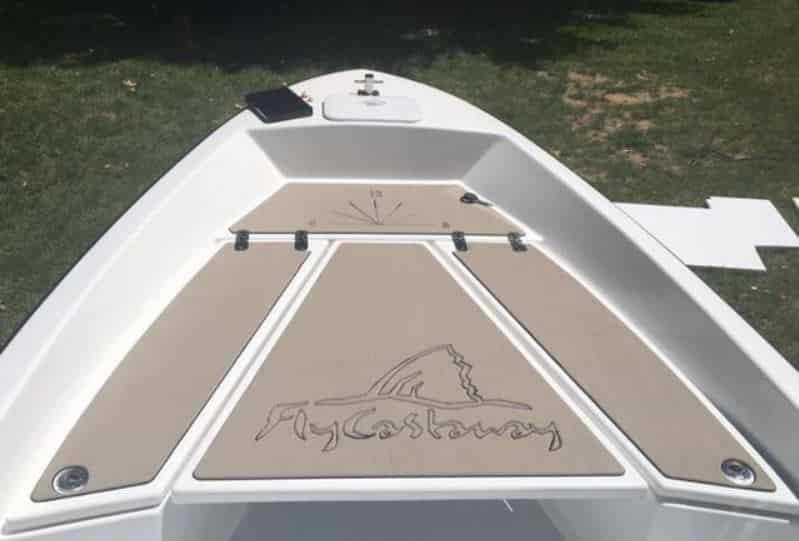
It is an elevated surface that is attached to the front or back part of the boat to allow the fisherman to fish without being obstructed by objects and have a better view of the water.
Forward casting decks often have storage or a live well below, perhaps a casting chair seat mount, as well as molded toe rails for improved protection.
#17 Dinette
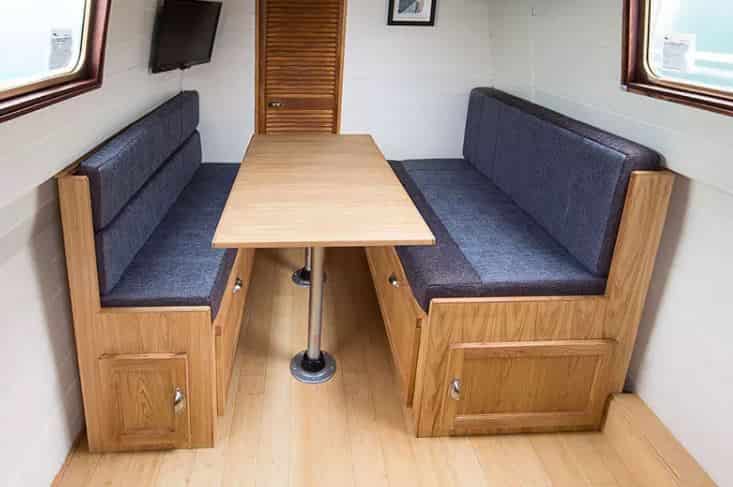
The dinette is located in the center of the boat, where the table and seats are used for dining. It is a flexible piece of furniture often found on narrow boats and some wide-beam canal boats as well.
A dinette is usually composed of a table and two to four chairs. Its function is to provide a seating or dining area, and small items can also be stored under the seating units. Some dinettes can also convert into single or double beds.
#18 Hard Top
As the name suggests, hardtops are rigid roofs that sit on top or console of a boat. The primary purpose of this roof is to provide protection from the elements for the driver and sometimes the passengers.
These roofs are more expensive than canvas tops, which is why budget-conscious boaters might not choose them over canvas tops. With the smaller vessel and forward windscreen alloy runout, you don’t really have the option of fitting a hardtop.
#19 Flybridge
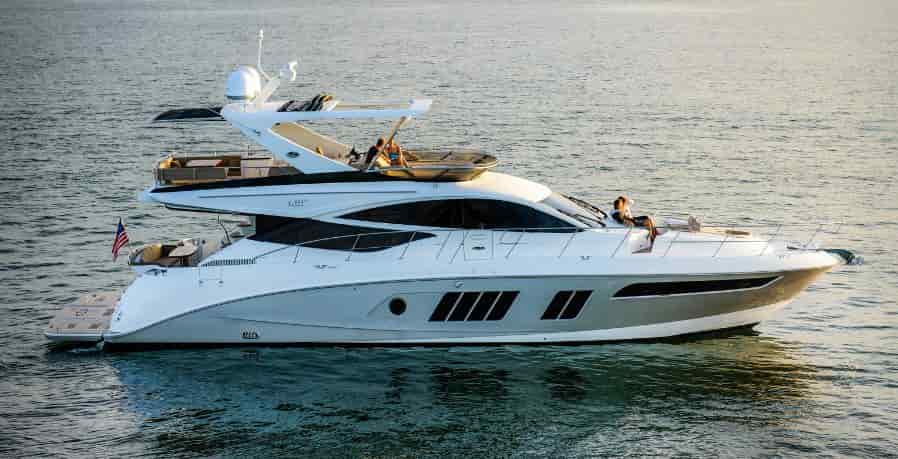
A flybridge is an area on top of a boat cabin, usually containing a steering system and sometimes a social space. In a cabin cruiser, it is located above the bridge on the cabin roof and usually contains a duplicate set of navigating instruments.
On larger boats, it is usually a raised second bridge placed on top of the superstructure, which has a steering wheel and other navigational instruments and can also be used as a seat and storage area.
#20 Hatch
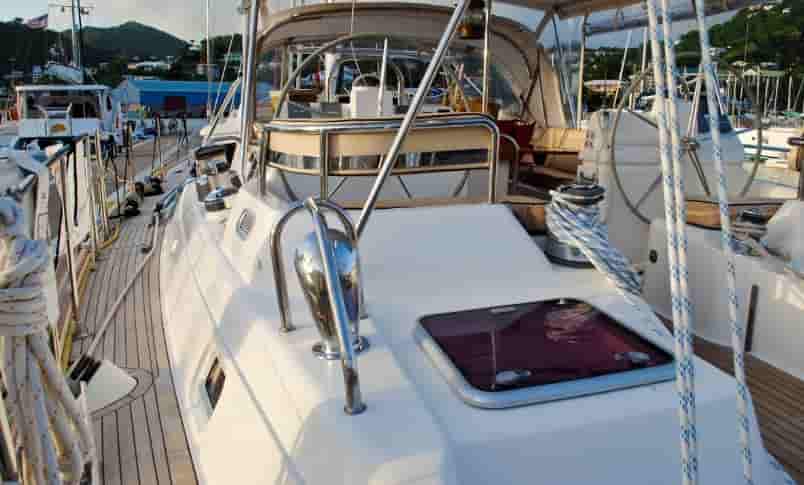
A hatch is a cover or portal through which storage, cargo, or additional living space within a boat can be accessed on deck. Also, it is an opening in the deck or cabin of a boat that serves as a window or door.
The primary purpose of hatch covers is to prevent water from entering cargo holds and to protect the cargo from getting wet and damaged. A well-constructed hatch should be waterproof, supporting the weight of people and objects placed on it.
Read Also: Types of Metals: Explained with Their Properties and Uses
#21 Helm
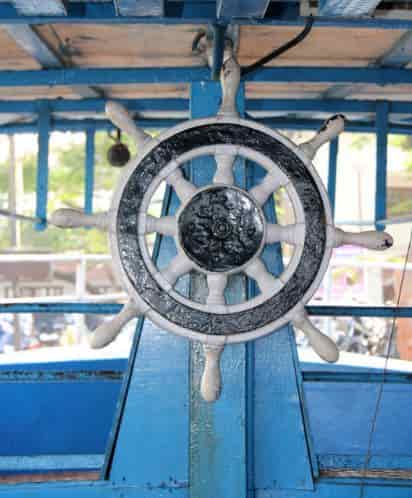
A helm is a mechanism that keeps the boat moving. A helm is a steering station consisting of engine controls and a wheel or joystick. It is usually located on a raised structure on the deck of a boat.
#22 Livewell
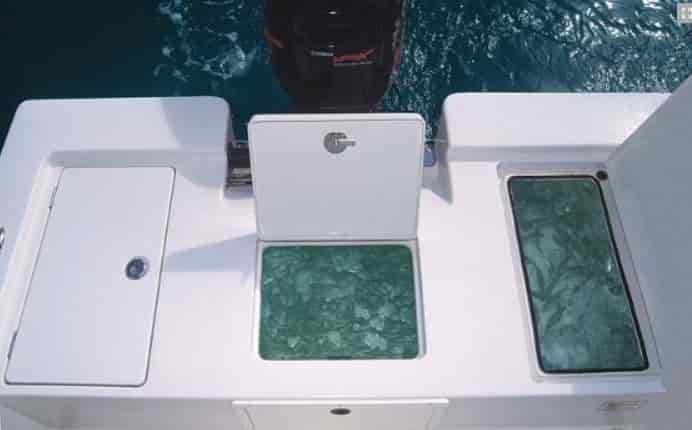
A Livewell is a type of storage tank designed to keep live fish or bait caught while fishing. This device serves to keep the water aerated and pump fresh water from nearby bodies of water into the tank.
The method for determining the required size of a Livewell is that each one-inch-long fish requires one gallon (3.8 liters) of water. In addition, they are two other important factors in Livewell functionality maintaining proper temperature and removing metabolic waste.
#23 Rigging
Rigging consists of a system of ropes, cables, and chains that support the masts of a boat. Ragging is further divided into two categories, standing and running. The standing rigging supports the mast, and the running rigging controls the orientation of the sails and their degree of reefing.
#24 Saloon
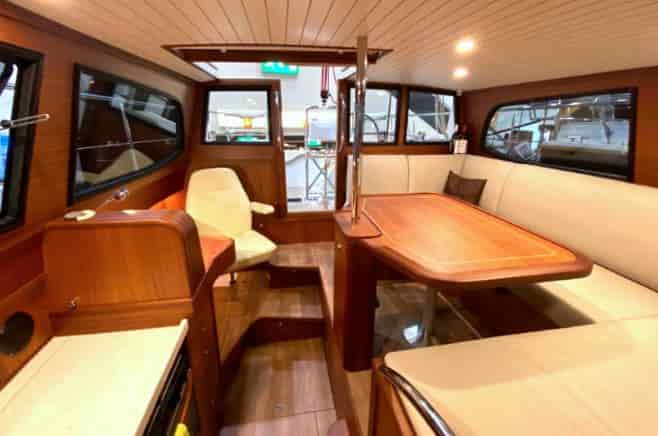
A saloon is a room built into a boat that is an internal social space used as a living room in a house. In addition, it is also known for a yacht cabin area dedicated to seating relaxation, often combined with a dining table.
#25 T-top
It is a composite structure designed to hold a roof to protect the boatman from the sun. A T-top is a metal frame mounted on the center console of the deck with a canvas or hard top.
By installing this part, fishers will have access to the standing-height shade while remaining unobstructed to move and cast. In general, T-tops are manufactured from high-quality marine aluminum extrusions, anodized for a longer lifespan.
Read Also: Basic Parts of Car Wheel Assembly and Its Function
#26 Transom
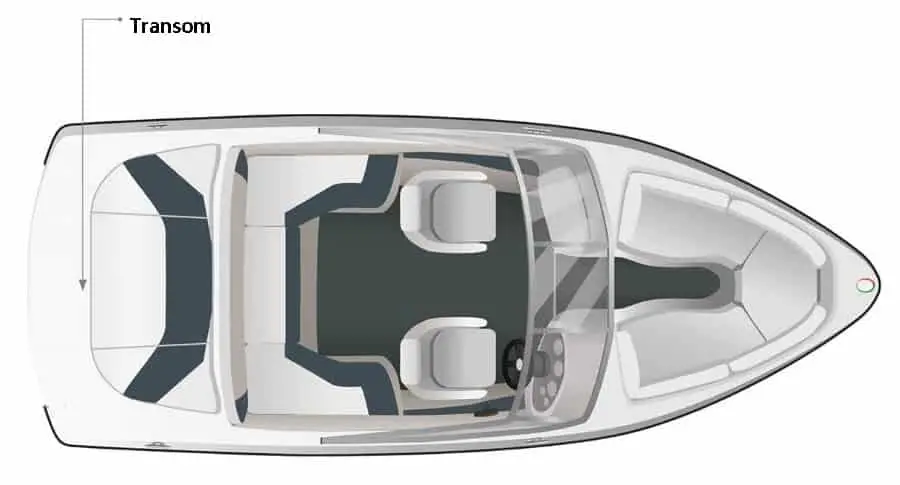
The transom is found at the rear of the boat, comes up from the bottom of the hull, and connects the two hull sides together. This is the area of the boat where the motor is attached.
In pontoon boats, the transom is typically metal and is located at the stern. This is essential because the transom extends the life of the boat’s rear material while maintaining the stern to support the added weight.
#27 V-Berth
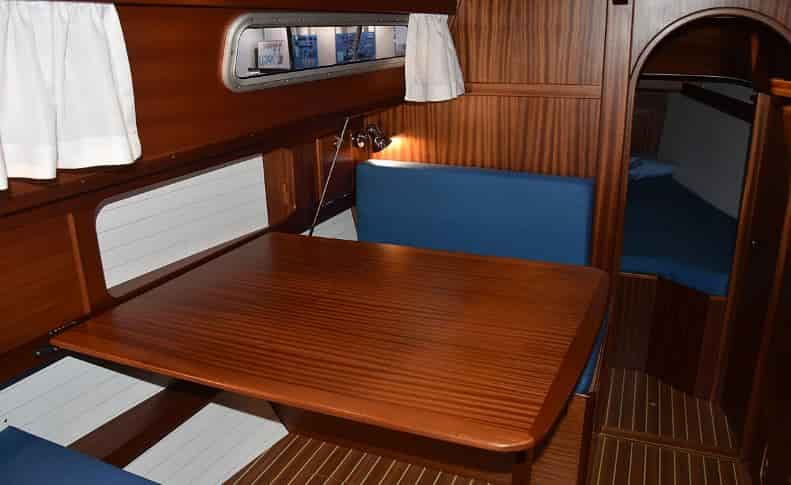
Often boats have a bed in the extreme forward end of the hull. In general, these beds are triangular due to the shape of the hull, although most have a triangular notch cut out of the middle of the aft end, making them more like a V-shape.
This notch can usually be filled with a detachable board and cushions, forming a double bed. In the United Kingdom, it is not very common to use the term “V-berth.” Instead, the entire cabin (forepeak) is more commonly referred to.
#28 Rudder
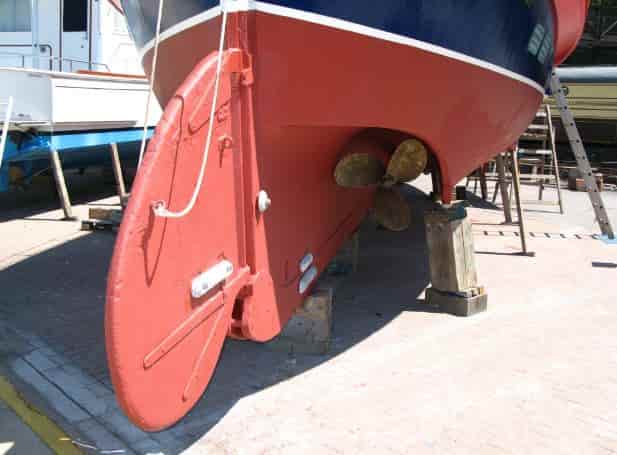
The rudder is the part of a boat steering mechanism that is mounted outside the hull, usually at the stern. A rudder works by redirecting the fluid past the hull, thus giving the craft a yawing or turning motion.
Basically, a rudder is a flat plane or sheet of material that rests after the stern, tail, or end of the craft. A rudder can also be used in a large ship, boat, submarine, hovercraft, aircraft, or other vehicles.
#29 Swim Platform
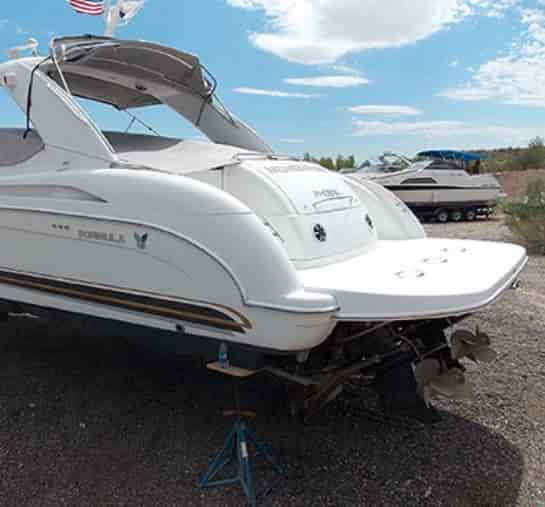
Swim platforms are fixed to the transom or aft portion of the boat to facilitate entry and exit from the water. It provides a place to board a boat when tethered to the side or stern. Water sports such as swimming, wakeboarding, and skiing can be enjoyed from a floating dock along this stretch.
#30 Console
It is an elevated structure that usually holds the steering station and may include a toilet or stowage space. The boat console also houses the ignition, trim controls, radio, and other electronic equipment, switches, etc.
In addition, it allows easy access to the bow, stern, and sides of the boat. In larger center console boats, smaller berths may also be located inside the console and below the deck. A center console is usually powered by an outboard motor and may have one or two, or even five, in the case of a very large model.
Read Also: 20 Car Interior Parts: Explained with Name & Functions
#31 All-round Light
An all-around light is a white light installed on a boat that shines continuously on the horizon in an arc of 360 degrees. These lights allow you to determine which direction the boat is headed. In addition, this light acts as an anchor light when the edge light is wasted.
#32 Fender
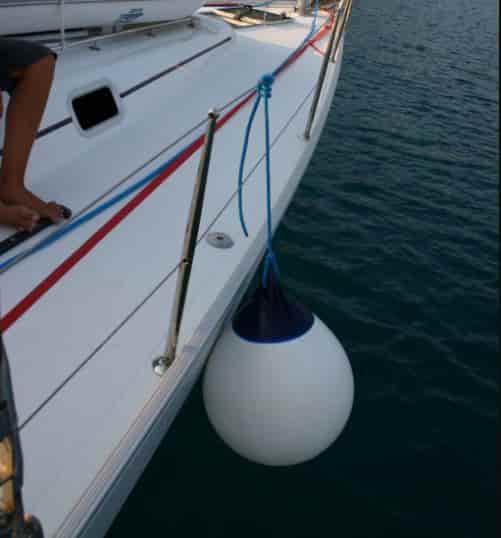
In boating, a fender is a bumper used against a jetty, wharf wall, or other vessels to absorb the kinetic energy of a boat. As it protects ships and berthing structures from damage, it is used on all types of ships, from cargo ships to cruise ships, ferries, and personal yachts.
Read Also: Types of Turbochargers are Best? Pros & Cons
Wrapping It Up
That’s it. Thanks for reading. I hope I have covered everything about this topic. If I missed something, or if you have any doubts, let me know in the comments. If you liked this article, please share it with your friends.
Want free PDFs direct to your inbox? Then subscribe to our newsletter.
Download PDF of this article:
You might like to read more in our blog:
Thank u I will follow and share your post!!
Thank you so much.
Please notify me about aerodynamic, renewable energy conversion and process control and experiment designs for engineer, I need short note from which best explanation of other your engineering post,which very good and more understandable.
Thanks for your response. I will definitely write on this topic in the future.